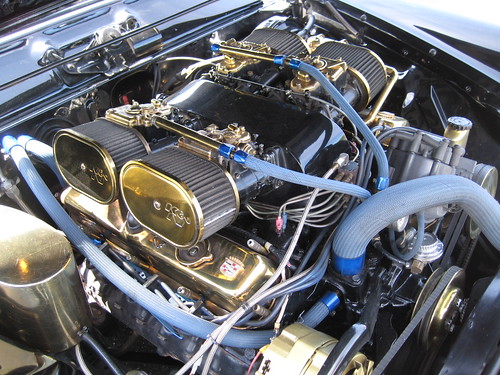 |
| Cadillac V8 (Flickr/Hugo 90) |
About five years ago, I was standing next to my grandfather watching a commercial for the
then-new Cadillac CTS and the announcer was touting its direct injected V6 with 300-something horsepower. My grandfather, long past his driving years but still filled with memories of his
'76 Coupe de Ville, turned to me and asked, "Does having a V6 cheapen a Cadillac?"
Grandpa raised a good point. I, raised on turbo fours and
preferring condensed European power to the brute force that's long been an American philosophy, thought it was a non-issue at the time. To him, a Cadillac wasn't a Cadillac without eight cylinders. (I wasn't born yet to ask him what he thought of the
Cimarron). He never really forgave GM for their downsizing in the '70s and '80s, either. If Grandpa were around today, I wonder what he'd say about the new
Cadillac ATS, the
3-series opponent that features two four-cylinders in its engine roster. He'd probably hate it. And, after much thought, I kind of have to agree with him.
 |
| 2013 Cadillac ATS (Flickr/Autoviva) |
It's the worst-kept secret that GM wants Cadillac to go head-to-head with Mercedes-Benz in the luxury field, specifically in Europe and China, where consumers have said time and again
they don't want a Cadillac. (I'm going to hold my tongue and not talk about how GM had, then lost, premium European customers with
a certain Swedish ex-subsidiary.) To counter that, GM is effectively reworking its flagship division in the mold of the Germans. The new ATS, unveiled last month in Detroit, is roughly the same size as a C-class or 3-series, with roughly the same engine lineup. In essence, it's closer to the compact sport sedan bullseye than Cadillac has ever been – far closer than with the
pudgy Catera.
Most of it sounds good on paper. Yes, the base engine is the
2.5-liter four out of the new Malibu, but you can upgrade to either a new turbo four or the fine direct injection 3.6 V6 out of the CTS. It's rear wheel drive, it's short and, in general, looks pretty good. But think about it: What does a Cadillac mean to you? To me, it's a big, blingy thing with lots of chrome and big wheels. It's a pretty showy car to be seen in. Granted, so is a Mercedes, but a Cadillac is more over-the-top. A Cadillac is American, it's supposed to follow the "bigger is better" mantra. A Cadillac with a turbo four doesn't sit well in my head.
_front_20100821.jpg/800px-BMW_530d_(F10)_front_20100821.jpg) |
| 2011 BMW 5-series (Wikimedia Commons) |
Neither does a
5-series with a turbo four, for that matter. BMW's been on a turbocharging kick of late, and it's merited some good results with the
universally praised six-cylinder turbo. The blown six is so good it makes me wonder why anyone would get a V8 5, 6 or 7-series over the six. A straight-six is a BMW hallmark. It's like a V8 Cadillac in a number of ways. That's why I think the turbo four, found in the new 528i among other BMWs, is wrong for that car. Admittedly, I haven't driven it yet. But I bet it's great and I do love a turbocharged four-pot. It just seems wrong in the big Bimmer. If I had less than $50,000 to spend on a BMW sedan,
I'd take a 335i over a 528i, hands down.
 |
| 2012 Buick Regal GS (Wikimedia Commons) |
The Germans have to downsize or die thanks to CAFE standards. Americans won't buy their diesels or hatchbacks in big numbers and as companies, they're relatively small. But their European customers overwhelmingly buy four-cylinders, too, even if they are diesels. For BMW, putting a small engine in a 528i is less of a stretch than Cadillac marketing a $30,000-plus car with a turbo four. Leaving aside their doomed European aspirations, where does the four-cylinder ATS fit within GM's portfolio? The company flogs lots of
little Sonics and
Cruzes to offset their big trucks and SUVs, and already has Buick selling the little
Verano and
Regal appealing to the lower end of the luxury class. I know enthusiasts would like to think a front-wheel drive Regal Turbo and rear-wheel drive ATS Turbo are on two different playing fields, but if they're about the same size and in the $30-40,000 ballpark, I'm going to say buyers are going to look at them similarly.
 |
| 2012 Chrysler 300 S (Flickr/sarahlarson) |
In GM's quest to make Cadillac the "standard of the world" again, they've made it rather German. And technically, that's fine. But as a brand, it could be kind of damaging. I, for one, wouldn't be caught dead in a Cadillac. They're still too showy and for the same money (or even less) I could have an Audi. They've said they've made the ATS as good as a 3-series. How's that going to convince anyone to get out of a BMW? If Grandpa were around (and driving) today, he wouldn't have a Cadillac.
A CTS-V coupe would probably be a bit much. He wouldn't have a Lincoln, either. So it'd have to be the Junior Bentley, the
Chrysler 300. It's big, brash, offers a V8, but is beautifully finished. Grandfather would approve. I just won't tell him it's an old Merc underneath. And the company's owned by Fiat. OK, everything can't be perfect.


_front_20100821.jpg/800px-BMW_530d_(F10)_front_20100821.jpg)

